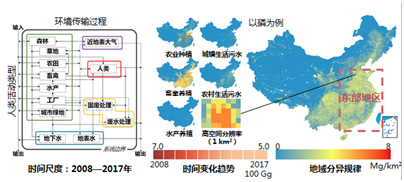Imbalance between nitrogen and phosphorus in wastewater affects algae

Lake eutrophication and frequent outbreaks of harmful algal blooms have become major environmental issues. The excessive input of nitrogen and phosphorus into the water caused by human activities has become more and more difficult to control due to climate change and other factors. Nitrogen and phosphorus, as the two most essential nutrients, play different roles in the outbreak and growth of algae in lakes.
Recently, a research project - conducted by Tong Yindong’s team at Tianjin University in collaboration with a number of well-known research institutions at home and abroad - showed that the large-scale construction of municipal wastewater treatment facilities is one of the important factors in causing the "dietary imbalance" between nitrogen and phosphorus in algae in lakes.
The resulting research paper, titled "Improvement in municipal wastewater treatment alters lake nitrogen to phosphorus ratios in populated regions", was recently published in the internationally-renowned academic journal Proceedings of the National Academy of Sciences of the United States of America.
According to the report, mastering the long-term evolution rule of the lake's nitrogen and phosphorus balance is a prerequisite for clarifying the changes in lake nutritional status and predicting the outbreak of harmful algal blooms, and it is also the basis for formulating lake nutrient management and control goals in the future.
Tong Yindong’s team investigated historical changes in the nutritional status of 46 lakes in China and found that over the past ten years, some lakes in the eastern part of China have begun to exhibit characteristics of oligotrophication, with the total phosphorus (TP) concentration decreasing rapidly and the total nitrogen (TN) concentration staying stable, while the TN/TP mass ratios increased in lakes. This change may be an important factor leading to the competitive advantage of non-nitrogen-fixing cyanobacteria in lakes.
Tong Yindong said that in order to explain this phenomenon, their research team combined a material flow analysis with a watershed transportation model, estimated the change of nitrogen and phosphorus flux into the lake, and found that since 2005, the nutrient input of China’s lakes has been changed from “general increase” to “partial decrease”, with a significant decline in urban household emissions (especially in the eastern lakes area).
The research also found that there is increasing nitrogen abundance relative to phosphorus in some anthropogenic emissions, causing an imbalance in the TN/TP mass ratio. In municipal wastewater discharge, due to the difference in the removal efficiency of nitrogen and phosphorus in wastewater treatment, the TN/TP mass ratio in the water has nearly doubled in ten years.
This research result shows that the construction of municipal wastewater treatment facilities that meet the needs of water ecology should not only consider functions of nitrogen and phosphorus removal, but should also be careful of the impact of element imbalance before and after wastewater treatment on the water ecological environment. This research provides an important basis for municipal wastewater treatment discharge standards that meet the needs of water ecology.

Copyright © Tianjin Municipal Government.
All rights reserved. Presented by China Daily.
京ICP备13028878号-35



